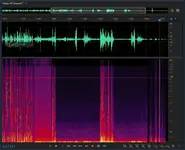rob aylestone
Moderator
When I upgrade, I sort of move the old gear about. In the office, working happily is my old Tascam US-1641 interface. I was doing some recording yesterday, and in Cubase, looking at the waveforms something looked odd. I was trying to record with the mics a long way away - not music, I'm testing for some sound effects recording, so the waveform levels on the screen were very low. I knew I'd have to normalise, and wanted to know if the noise would be acceptable. I had on a pair of Beyer DT100 headphones to try to keep the room noise out, and with an omni mic, the computer fans were there, and switching to cardioid, wanted sounds was OK and the fans went down quite a bit, as expected. While I was recording I noticed the occasional waveform appear when I heard nothing? I normalised it and there was a clearly obvious sound source. I could not hear this thump. I used Cubase's spectrum feature which draws a graph, and there was a peak - a very sharp one - just below 10K. Bunging this into Audition, as I like the spectrum display there shows a continual feint line at just below 10K and quite a bit right at the very bottom. A direct test into Audition reveals that this signal at 10K occasionally gets louder. Not by much, and with the room noise and stuff, It's not a 'tone', it's hidden by the background noise, but it is there. It is not the mic - unplugging makes no difference and it appears generated on the tascam output on all channels.
Anybody ever heard/seen this before. A phantom tone generated by the interface. Look at this image - you can see the silent parts of the recording, but that tone is there all the time?
Anybody ever heard/seen this before. A phantom tone generated by the interface. Look at this image - you can see the silent parts of the recording, but that tone is there all the time?

